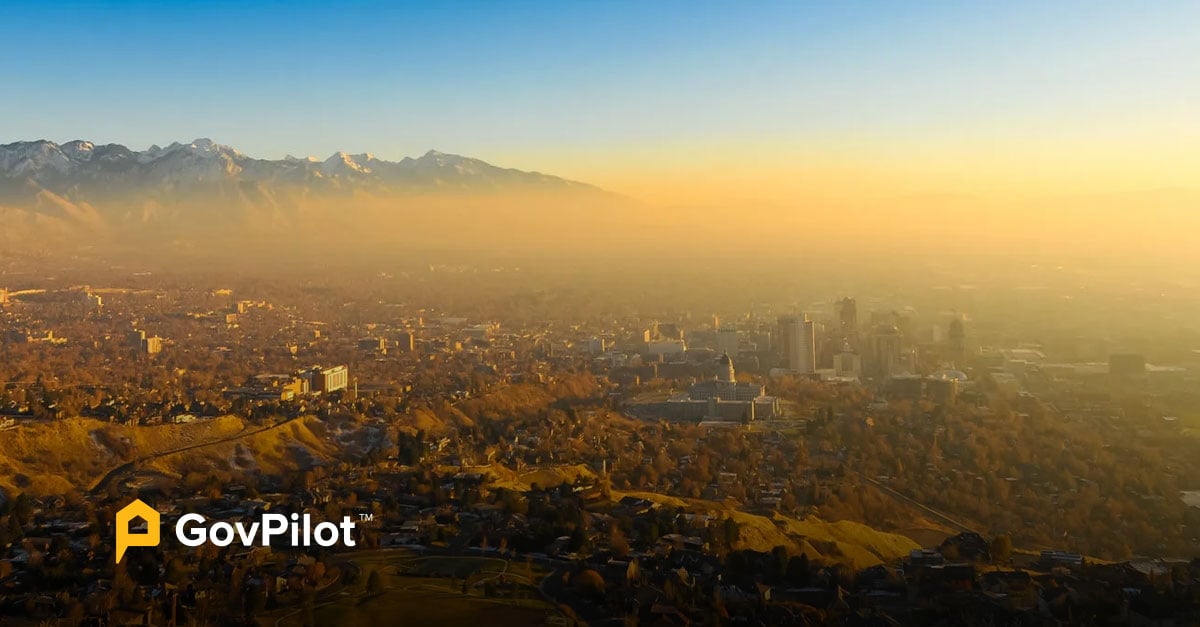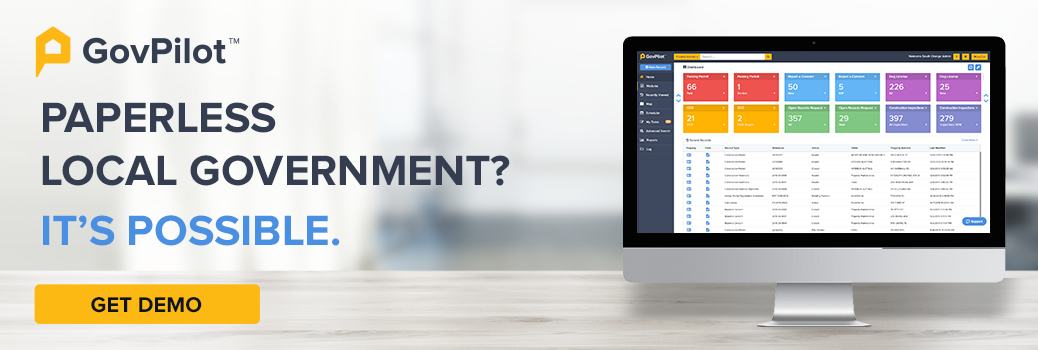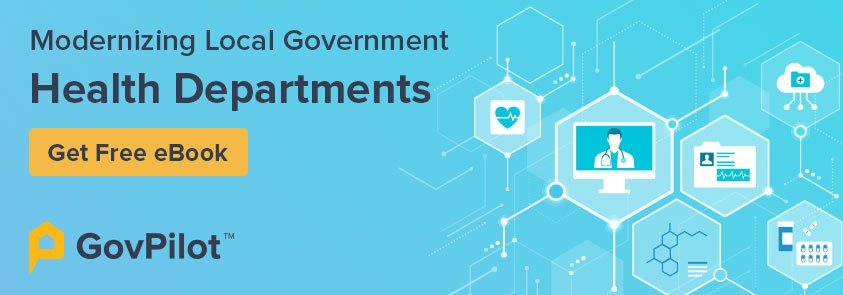It’s no surprise that attention is being brought to the continually worsening air quality in the United States. Since 1980, when the new Clean Air Act was implemented, there has been an estimated 50 percent decline in emissions of key air pollutants. Yet, new research proves that this decline is not nearly enough to protect the most vulnerable Americans from the damaging effects of air pollution.
Due to America’s over-reliance on cars and heavy investment in industry, the air quality is unfortunately subpar overall. At the local level, zoning policies can have a direct impact on the air quality and physical health of your citizens.
In this guide, we’ll highlight why air quality is a local issue and how municipal and county zoning, health, and parks and rec departments can collaborate to improve the air quality at the local level.
Why Should Air Quality Matter To Local Governments?
Local governments should dedicate focus towards the air quality of their community because it’s a local issue that directly affects the health and physical well-being of all citizens.
According to the United States Environmental Protection Agency, “Decades of research have shown that air pollutants such as ozone and particulate matter increase the amount and seriousness of lung and heart disease and other health problems”.
Unfortunately, the citizens who often face the worst impacts of air pollution are already underserved or living under the poverty-line, and have less time and resources to protect against dangerous environmental events. To mitigate this, prioritize upward mobility in your community; provide citizens with the resources they need to stay safe against air pollution in your area.
Public health is severely impacted by the lack of air quality control in many local communities. Learn more about other key Issues Local Governments are Dealing With Today.
What Impacts Air Quality at The Local Level?
There are many relatively small ways that air quality can be improved at the local level. During your government strategic planning, focus on reducing the following causes of poor air quality that may be affecting your community.
1. Heavy Reliance On Cars And Highways In Populated Areas
Car usage and over-populated highways are a huge air pollutant in the United States, contributing to a range of health problems for citizens and unchangeable ozone layer damage. Encourage your citizens to carpool as often as possible, or opt for walking/biking for short-distance trips.
Making your city more accessible without relying on a car is the best way to get ahead of air pollutants from cars. Explore these resources for inspiration:
- Actionable Steps to Becoming a 15-Minute City
- Embracing Pedestrian Zones & Bike Lanes at the Local Level
- Bringing E-Bikes to Your Community
2. Industrial Plants And Factories
Industrial plants and factories produce massive amounts of toxic materials, such as carbon dioxide and methane, which are burned and released directly into the atmosphere. Carbon dioxide and methane absorb radiation directly from the sun, immensely affecting the temperature of the planet.
Increasing regulation and restrictions for the amount of pollutants being produced by these industrial plants and factories will make pollution easier to control and monitor.
Here are the components of a Modern Local Code Enforcement Strategy for governments.
3. Wildfires
As wildfires burn, they impact weather patterns and climate temperatures, causing large quantities of carbon dioxide, carbon monoxide and fine particulate matter into the atmosphere. Controlled burns of forests and other wooded areas account for a large portion of wildfires, and should be limited to cases where it is extremely necessary.
Smoke from wildfires can travel significant distances and impact the health of people and animals miles away. In 2023, strong winds blew smoke from wildfires south from eastern Canada all across the United States, resulting in a 400+ AQI on some occasions in New York, New Jersey, Pennsylvania, and even further south and west.
People in parts of New Jersey, Pennsylvania and elsewhere with heart disease, asthma and other health issues were told to avoid the outdoors.
Learn more about Modern Local Government Wildfire Mitigation & Response Strategies.
4. Construction And Demolition
The process of construction and land demolition cause air pollution due to the operation of heavy machinery and other construction vehicles with diesel engines. These engines release pollutants into the air including carbon monoxide, carbon dioxide, nitrogen oxides and hydrocarbons.
Consider eco-friendly building materials in your local code, and develop relationships with local developers to work towards more sustainable construction processes together. Here are considerations for modern Government Building & Construction Inspections.
5. Agriculture Chemicals
Agricultural pollution is contamination that is released into the environment as a by-product of growing and raising livestock, food crops, and biofuel crops. Farmers use pesticides to keep away any unwanted weeds or pests. Toxic chemicals such as these bring on serious side effects such as chronic diseases like endocrine and neurological disorders and cancer.
Form a Local Government Agriculture Strategy to determine actionable ways to reduce agricultural pollutants in collaboration with farmers in your community.
How Local Governments Can Improve The Local Air Quality
Starting today, the government can reduce air pollution by taking steps to improve local air quality in your community via an air pollution management plan.
Here are important components to include in your strategic planning:
-
Enforce Local Code For Impactful Industries
Your local government needs to hold industries such as agriculture, transportation, construction, and manufacturing accountable for environmental laws and codes that they must follow in order to reduce their air pollution levels.
GovTip: Code enforcement software allows you to perform inspections via a digital from a government mobile field device like a tablet. Specific local, state, and national codes can be pulled up in real-time to make sure you don’t overlook any requirements that will keep the local air quality safe.
-
Zoning Factories In Non-Residential Areas
Zoning is a crucial part of city planning and can be used to strategically organize your city in a way that benefits all community members. Keeping factories and industrial plants away from residential areas will protect citizens from breathing in harsh and intense chemicals and pollutants that are released in the areas surrounding an industrial plant.
Learn How to Set KPIs as a Government Leader and the most effective ways to Review The Performance Of Your Government to effectively perform data analysis on how current endeavors are measuring up to your air pollution management plans.
-
Urban Planning That Prioritizes Car-Free Neighborhoods
Neighborhoods with accessibility to amenities without a car have far better air quality than cities that completely rely on motor vehicles for travel. If citizens are able to opt for walking or biking around your community, tailpipe emissions and other harmful chemicals that gas-fueled vehicles produce will be reduced.
Prioritizing Modern Public Transit can also reduce the number of cars on the road by increasing accessibility.
-
Prioritizing Electric Vehicle (EV) Infrastructure
If your locality is going to continue to rely on cars as a primary means of travel, prioritize electric vehicle infrastructure. When accounting for harmful emissions, research shows that an electric vehicle is responsible for lower levels of greenhouse gasses than average gasoline cars.
EV infrastructure promotes a more environmentally friendly means of transportation, and the infrastructure itself, such as public EV charging stations, is easy to introduce into your community.
Learn more about How Local Governments Can Embrace EV by checking out our resource.
-
Partnership With Local Business To Prioritize Sustainable Practices
Local businesses can help you reduce air pollution in your community by individually making changes in their businesses that have a positive impact on the environment. Local businesses should be given financial incentives to provide more environmentally friendly options to customers and reduce their carbon footprint.
Learn more about Local Government and Private Sector Partnerships and How Local Governments Can Drive Economic Development.
-
Wildfire Mitigation
Wildfire mitigation is the implementation of precautionary measures that protect buildings from a wildfire. Homes in heavily forested or dry areas should be inspected often and modified in order to be considered up to code.
Here are Disaster Preparedness Tips for Local Governments to consider.
How Can Government Technology Help Air Quality?
Local government technology provides limitless opportunities to support the effort of growing eco-friendliness of your community. Here are the different ways that government tech can help improve air quality in your community.
1. Virtual Inspection Forms
Customizable inspection forms can be used to perform anything from health inspections to building inspections. When assessing local businesses and properties, make sure to add details around your air pollution management policies in your customized forms to ensure key air quality issues aren’t overlooked.
Here are helpful tips for mastering various inspection types:
- How Health Departments Should Perform Aquatic Facility Inspections
- How Health Departments Should Perform Retail Food Inspections
- NJ Lead Paint Inspection Laws (& Paint Inspection Lessons for Any State)
2. Enforce National, State, And Local Codes Pertaining To Air Quality
Eco-friendliness should be prioritized during regular inspections because code enforcement of local and national laws is the most effective way to protect local air. Local air pollution management requires government workers to thoroughly inspect buildings and worksites so that sustainability and decreasing air pollution are prioritized.
Here are more ways to be a Sustainable Local Government.
3. Complaint Management For Reporting Fires
Reporting fires as soon as they begin to break out will help authorities extinguish them sooner, and dramatically reduce the amounts of carbon dioxide, carbon monoxide and fine particulate matter that are sent into the atmosphere.
Utilize Report-A-Concern Software to receive immediate updates when citizen’s report wildfires, and learn more about How Complaint Management Software Works through this resource.
4. Online Communications Channel To Correspond With Local Businesses
Maintaining an open line of communication between your local government officials and local business owners improves businesses ability to reach out to their local government with any concerns they may have regarding codes or environmental laws. This open virtual communication is a superior way for governments to review countless submissions with the click of a virtual button.
Explore this resource for Mastering Local Government Communications.
Prioritize Improving Local Air Quality Now
Local air quality has never been more important to protect and maintain than it is now. A local government air pollution strategy is necessary to control the rates of air pollution in your area, and to create a healthier environment with more breathable air for all citizens. Air quality should matter to local governments because there are many steps that can be taken to decrease air pollution at the local level.
To learn more about how GovPilot’s government management software can help with managing your local government’s air pollution strategy and improving your local government’s efficiency, Book A Consultation With GovPilot.
Local Air Quality FAQ’s
1. Why does local air quality matter?
Local governments have the ability to get to the heart of local air pollution issues within their communities and limit harmful emissions. Air quality affects everything from the environment to public health.
2. How does local air quality impact public health?
Air pollution causes and worsens existing health issues for vulnerable groups such as the elderly, or people with pre-existing conditions including heart and lung issues. Ensure that vulnerable or marginalized groups in your community continue to be represented with equity to protect those who need it most.
Learn more about How To Promote Equity In Local Government.
3. What industries negatively impact air quality?
Many industries affect air quality in a negative way, including the transportation, construction, and agricultural industries. Local governments air pollution management plans need to consider the role of these industries.
4. Can infrastructure funds help local governments face air quality?
The infrastructure bill is giving federal grant dollars to state and local governments to address air quality. The Texas infrastructure bill grants, for example, set aside $121 million thus far to address pollution clean-up and make the community safer and air cleaner.
5. How can government GIS technology help mitigate air pollution?
GIS, or Geographic Information Systems is technology used for capturing, storing, analyzing, and displaying data in relation to specific locations, communities, or environments. With the power of GIS local governments can track air quality conditions and learn which areas of the community require the most improvement in air quality.
Read on:
- Modern Local Government Challenges
- Tips for Public Health Directors to Consider
- NJDOH Health Grants for Local Governments
- Public Health Data Management & Storage
- Best Public Records Technology
- Local Government Data Storage
- What is the Local Government Cloud
Sources:
- https://www.epa.gov/air-research/research-health-effects-air-pollution
- https://www.nytimes.com/2021/06/28/well/live/air-pollution-health.html
- https://cleanair.org/industrial-air-pollution/
- https://www.nrdc.org/stories/industrial-agricultural-pollution-101
- https://apnews.com/article/science-fires-environment-and-nature-wildfires-cebad62e9bf8d5ed295b60fb9b0961fb
- https://www.cbsnews.com/philadelphia/news/pa-nj-de-air-quality-alerts-smoke-maps-smoke-path-forecast-code-red-code-orange-explained/








